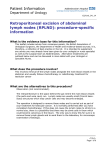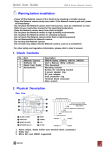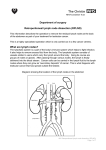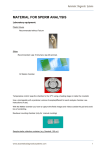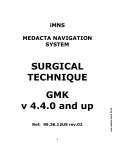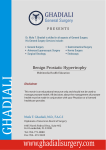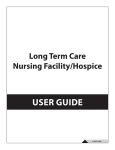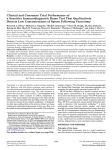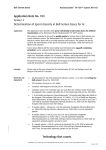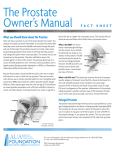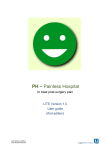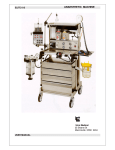Download Information About Your Prostate Operation (Transurethral Resection
Transcript
DEPARTMENT OF UROLOGY Information About Your Prostate Operation (Transurethral Resection of The Prostate) TURP Information About Your Prostate Operation Introduction You may be reading this booklet because following recent investigations it has been decided that you need an operation called a TURP (Trans Urethral Resection of he Prostate Gland). You will have been informed about the reasons for the operation and what is involved. When faced with the sudden thought of a prostate operation sometimes people may not fully understand what the operation entails and are embarrassed to ask questions. This booklet has been designed to provide you with information about the operation and to try to answer questions which many patients often raise. We hope that this booklet will provide most of the answers to any worries or doubts that you have. If you have a problem and feel that the booklet can not provide the answer please discuss them with either the nursing or medical staff on your ward who will be happy to answer them. bladder down the penis. The prostate gland produces a watery fluid to carry the male sperms. As man gets older they can develop enlargement of the prostate, this usually occurs form the age of 40 onwards. As the prostate grows it can interfere with the normal passage of urine via the water pipe. Prostate enlargement is said to be connected with the natural hormonal changes associated with ageing. Location of The Prostate Front View What and where is the prostate gland and what does it do? The prostate gland lies immediately below the neck of the bladder. It is shaped like a ring doughnut around a tube called the urethra (water pipe) which drains the urine from the Side View What Can Go Wrong With The Prostate? Since the prostate surrounds the urethra, its increasing size will tend to narrow the urethra (Water pipe) which is surrounded by the prostate and can make it more difficult for a man to pass his urine. ( Similar to if you were to stand on a hose pipe and the flow becomes restricted) Typical symptoms experienced include; frequency of voiding, difficulty getting the bladder to empty and when severe may result in a complete stoppage requiring emergency admission to hospital. The enlarged prostate can lead to urine infections, bladder stones, bleeding and if left untreated, damage to the bladder and kidneys. Why is it necessary for me to have a Prostate Operation? There are several reasons why you may need prostate surgery these include; • to avoid crisis management • Bothersome water work symptoms. • Where symptoms have not been controlled by medication. • Patient preference • Sudden inability to pass urine • Not emptying the bladder properly What does the prostate operation involve? After you have been anaesthetised a narrow telescope called a resectoscope will be carefully inserted in to penis. This allows your Consultant to see the prostate and also inside the bladder. The obstructing part of the gland is removed by cutting away pieces of the prostate using a wire loop which uses heat from an electrical current. The prostate pieces (Chipping’s) are then washed out of the bladder, down through the water pipe, they are then weighed and sent away for further examination under the microscope. Because the operation takes place through the penis there is no visible scar or wound. It must be remembered that you have been cut inside and therefore you will need to allow time for healing to take place after your surgery. What are the alternatives to the prostate operation? Alternatives to surgery would be medication for symptom control or observation to ensure symptoms are not affecting the kidney function. Postponing surgery if symptoms are severe can result further deterioration in urine symptoms, infection bladder stones, muscle failure and possible kidney damage. How long does the operation take? The operation takes about 40 minutes. However this can vary with each individual as prostates are not all the same size. View of the Prostate Bladder • A risk of blood loss both during and immediately after the prostate operation. You may therefore need to have a blood transfusion. On rare occasions If the bleeding Capsule Enlarged Prostate Gland to be Removed Urethra View Of A Prostate Being Resected • continues a further operation may be required to help stop it. • Urine infections are common following a TURP and tend to be associated with the catheter. Antibiotics are prescribed if necessary. • There is a risk of thrombosis (Blood Clot) following surgery a. Bladder b. Resectascope Removing from Capsule d. Urethra Are there any complications from the TURP I must consider? It is important to consider the risks and possible problems you may encounter when making the decision to have this operation. The most common problems immediately following a prostate operation can include; Other fairly common problems you may experience Additional problems you may experience following your operation are associated with removal of your catheter and include; • A mild burning sensation • Frequency in the need to pass urine • Occasional bleeding when passing urine • Straining to open the bowels can restart the bleeding Before the operation If you have not attended a preadmission clinic, investigations will be performed on the day of your admission and you will be examined by a doctor who will make sure you are fit for surgery. Documents will be completed by a nurse who will take details of next of kin, medications, current illnesses and previous operations. A theatre list should be available so you will know when to be starved from. You must not eat for 6 hours before the surgery however, you can drink up to four hours before going to theatre. A “Pre-Med.” which can either be an injection or tablet, may be given to relax you before theatre. On the day of your operation a nurse will accompany you to theatre. What about the anaesthetic? The operation can take place under a General anaesthetic where you are asleep or under a spinal anaesthetic where you will be awake but feeling no discomfort as the epidural anaesthetic makes you numb from the waist down. The anaesthetist will discuss with you the options and help decide which is best in your particular case. How long will I be in Hospital? You are likely to be in hospital for about 3-5 days. Around 90% of people are discharged by day 4 after their operation. However some people may stay longer. After the operation When you return to the ward a nurse will monitor your pulse, and blood pressure at regular intervals. You will have a tube called a catheter which enters into your bladder through the penis. The tube will be connected to a bag to allow the Urine to drain out. The first thing you may notice is a large bag of clear fluid which is attached to a tube and is known as irrigation this enters into your bladder via the catheter and helps flush out any debris and blood clots which may be in your urine and which could block the catheter. Do not be alarmed if you see blood in your urine. During the operation the prostate area inside the body has been cut. This needs to heal and like all areas of the body when cut, before it heals it may bleed. It may appear bright red as it is normal to get some bleeding at this stage. Occasionally your nurse may need to wash out the bladder to release any blood clots which may form in the bladder. The urine should return to a near normal colour after 24 - 48 hours. The catheter will be removed 24 - 48 hours following the operation. This operation is not usually very painful but should you experience any pain or discomfort , pain killing medication can be prescribed by a Doctor which should control the pain adequately. You may have a drip in your arm to provide you with the necessary fluids and nutrients until you are able to eat and drink. This can vary according to the time of day you return from theatre. Do not be alarmed if you see blood in your urine. During the operation the prostate area inside the body has been cut. This needs to heal and like all areas of the body when cut, before it heals it may bleed and appear bright red as it is normal to get some bleeding at this stage. Occasionally your nurse may need to wash out the bladder to release any blood clots which may form in the bladder. The urine should return to a near normal colour after 24 - 48 hours. To help the urine clear it is important that you drink a least 2.5 - 3 litres of fluid. The catheter will be removed 24 - 48 hours following the operation. • A few patients do have temporary difficulties when passing urine and may need to have a temporary catheter inserted to help drain the bladder. This can be a result of the bladder muscle which has been stretched for a long period of time, and It may be necessary to rest it. A small portion of men have to go home with their catheter in place for a about 6 weeks. Very rarely, some men less than 1% need to have a catheter in place for good. • Removal of the prostate does not usually affect a man’s ability to have intercourse. However one lasting change from the operation can be a dry orgasm (Retrograde Ejaculation). Before the operation there is a mechanism in place to stop the semen moving up the urethra into the bladder at orgasm. After the operation the cored out prostate offers less resistance and so allows the semen to travel up into the bladder. This is not harmful and you will pass the semen out when you next pass urine. This effect is irreversible meaning you are unlikely to father children after this operation. • It is common for men who experienced urgency (the need to rush to the toilet) prior to surgery may find this persist for sometime afterwards, in some cases it can be several months. This can be temporary and improve in time or may need to be controlled with medication if it persists. Very Rare Complications include; • About 1 in 10 men who have a TURP will require another within a 10-year period. This can be due to scarring or as a result of re-growth of the prostate tissue. • Another very rare problem is a small risk that the operation may damage the sphincter mechanism which acts as a valve to stop the urine leaking out, leading to urine incontinence. Usually a TURP improves leakage. • An unexpected Prostate Cancer identified on the tissue removed from the prostate. Passing Urine Once the catheter has been removed you may experience some discomfort on passing urine and feel the need to go very quickly, frequently and have difficulty with controlling. This usually settles down after a few days as the cavity of the prostate begins to heal. Most patients usually pass water within a few hours of the catheter being removed. Once you have gained sufficient bladder control you will be ready to go home. Your urine may still be slightly pink. This can continue for some time as it can take at least a month for the prostate to heal fully. During this time you can expect symptoms to steadily improve and feel the full benefit of the surgery. Small blood clots may continue for a number of weeks and is due to the wound healing and scabs falling of into the urine. It is important to avoid straining to have bowels open. At Home • You should be able to drive within 2 weeks following your surgery • You can resume sexual intercourse after 6 weeks provided that it feels comfortable. • Unless you have a manual job you can return to work after three to four weeks. What problems should I Look out for when at home? There are a few problems which you may experience once you are home. If you do develop any of these problems we would suggest you contact your GP as soon as possible:- When you return home it is important to take things easy. You may notice that you pass urine more frequently than before, but this will subside as your operation site begins to heal. Try performing pelvic floor exercises and bladder retraining as these can often help gain some control. • Sudden reappearance of a heavy bloody discoloration which continues for 24-48hours making it difficult to pass urine • It is advised that you do not do any heavy lifting or strenuous exercise for approximately 3 weeks following your operation to allow the wound to heal. • Not being able to pass urine at all • Cloudy, Burning or Stinging on passing urine, this may mean you have an infection. • Severe pain in the lower part of the abdomen. • Passing small volumes frequently. • If possible try to avoid constipation as straining to have your bowels open can cause further bleeding. Further information If you require any further information after reading this booklet, please contact: Sara Wills, Ann Moore, and Theresa Neale. Urology Clinical Nurse Specialist Warwick Hospital Lakin Road Warwick CV34 5BW Tel: 01926 495321 ext. 4062 (Monday - Friday, 9am - 5pm) Fax: 01926 482602 e-mail: [email protected] [email protected] [email protected] www.warwickhospital.nhs.uk As a public organisation the Trust has a statutory obligation to promote race equality. This is set out in the Race Relations (Amendment) Act 2000. Our Information for patients can also be made available in other languages, Braille, audio tape, disc or in large print. PALS We offer a Patient Advice Liaison Service (PALS). This is a confidential service for patients and their families to help with any questions or concerns about local health services. You can contact the service by the direct telephone line on 01926 600054, using the phone links which are available in both hospitals or calling in at the office located at the main entrance at Warwick Hospital. Revision1: Dec 2004 Review: Dec 2006








